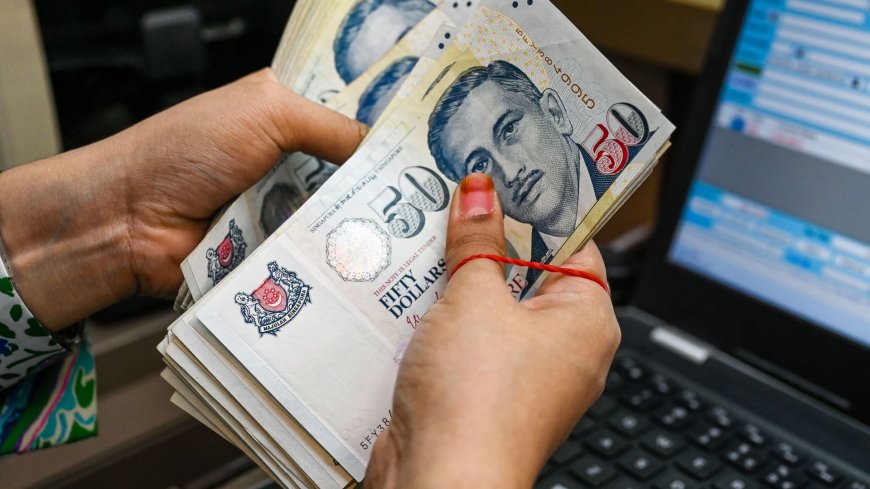Is the Singapore dollar the next safe-haven currency?
Amid weakening traditional safe havens like the US dollar and Japanese yen, the Singapore dollar is gaining attention for its defensive characteristics during financial stress. Analysts highlight Singapore's strong institutional framework, stable economy, and prudent policy making as factors contributing to the SGD's appeal. While facing challenges such as market size and export reliance, experts believe the SGD has the potential to become a significant global safe-haven currency.

A staff member counts Singapore dollar currency notes at Raffles Place financial business district in Singapore on October 6, 2022. Roslan Rahman | Afp | Getty Images
In times of uncertainty, investors turn to safe-haven assets such as gold, Treasuries, and currencies like the Japanese yen, U.S. dollar, and the Swiss franc. These assets are expected to retain or increase their value during periods of market turbulence. While the greenback remains the world's reserve currency of choice, it has been weakening. The dollar index has fallen over 9% year to date. The outlook for the Japanese yen has been clouded by trade worries. Against such a backdrop, analysts suggest there could be an alternative in the making: the Singapore dollar.
Christopher Wong, FX strategist at OCBC, told CNBC that the SGD already functions like a 'quasi safe-haven' currency, particularly within Asia and emerging markets. While it does not possess the same global status as traditional safe havens like the USD, JPY, or CHF, SGD tends to exhibit defensive characteristics during episodes of financial stress — especially those centered in Asia. The SGD has been strengthening against the dollar, gaining about 6% year to date, with Jefferies reportedly forecasting that the currency could reach parity with the dollar in the next five years.
'The SGD is indeed one of the world's safe havens, but it may not be 'the' next safe haven,' according to Omar Slim, co-head of Asia Fixed Income at PineBridge Investments. 'What makes it a safe haven is the strength of Singapore's institutional framework, the solid and resilient economic foundations of Singapore, as well as strong policy making, especially when it comes to fiscal prudence,' he said.
Felix Brill, chief investment officer at VP Bank, agrees that the SGD has many characteristics of a modern safe haven, including macroeconomic stability, strong institutions, a large current account surplus, and low political risk. Brill said that Singapore's monetary policy framework has delivered 'exceptional stability' to the currency, which is exactly what safe haven flows seek. Unlike most nations, Singapore does not use interest rates to manage its currency, but instead strengthens or weakens the Singapore dollar against a basket of its main trading partners in a policy band. The exact exchange rate is not set, rather the SGD can move within the set policy band, whose precise levels are not disclosed.
Jeff Ng, head of Asia Macro Strategy at Sumitomo Mitsui Banking Corporation, estimates that the policy band has a width of 4%, and said this management of the SGD means that there is limited volatility, which gives reduced risks and more certainty over the short term.
While the SGD is on the right track, experts said there were some roadblocks in its way to becoming the next widely accepted global safe-haven currency. The first is the size of the SGD market. Data from the Bank of International Settlements in 2022 revealed that the USD made up 88% of the forex market, while the yen and the Swiss franc made up 17% and 5%, respectively. The Singapore dollar made up just 2%. 'Although Singapore is highly respected, it has a small economy, and the SGD does not have the trading volume or bond market depth of the yen or franc,' VP Bank's Brill said.
Furthermore, the monetary policy that Singapore has in place that has delivered exceptional stability for the SGD is the very thing that constrains it. Brill explains as the currency is 'managed,' it limits market speculation and large-scale positioning, which in turn cap its liquidity and depth. These are key traits that investors look for in a true global safe haven. 'So yes, the framework helps credibility — but hinders scale,' Brill said. Other factors include Singapore's export-reliant economy. Figures from the World Bank show that exports made up 178.8% of the city-state's GDP in 2024.
As such, the Monetary Authority of Singapore might not have appetite for the SGD to appreciate too much, according to Trinh Nguyen, senior economist at Natixis Corporate & Investment Banking. 'Should investors buy too much SGD assets, that would push up the SGD,' Nguyen pointed out, adding 'If the SGD becomes uncompetitive ... MAS would not tolerate that as it sees it as detrimental to Singapore's competitiveness.' SGD could be used for mitigating currency risk. Jean Chia, global chief investment officer at Bank of Singapore, said that the SGD could play a 'very important part in terms of diversification ... So this could be the third currency in many of your currency diversification discussions.' Experts agreed that Singapore's currency holds potential to gradually acquire the status equivalent to that of the Swiss franc if not the yen or the greenback.
What's Your Reaction?
 Like
0
Like
0
 Dislike
0
Dislike
0
 Love
0
Love
0
 Funny
0
Funny
0
 Angry
0
Angry
0
 Sad
0
Sad
0
 Wow
0
Wow
0























































































































































































